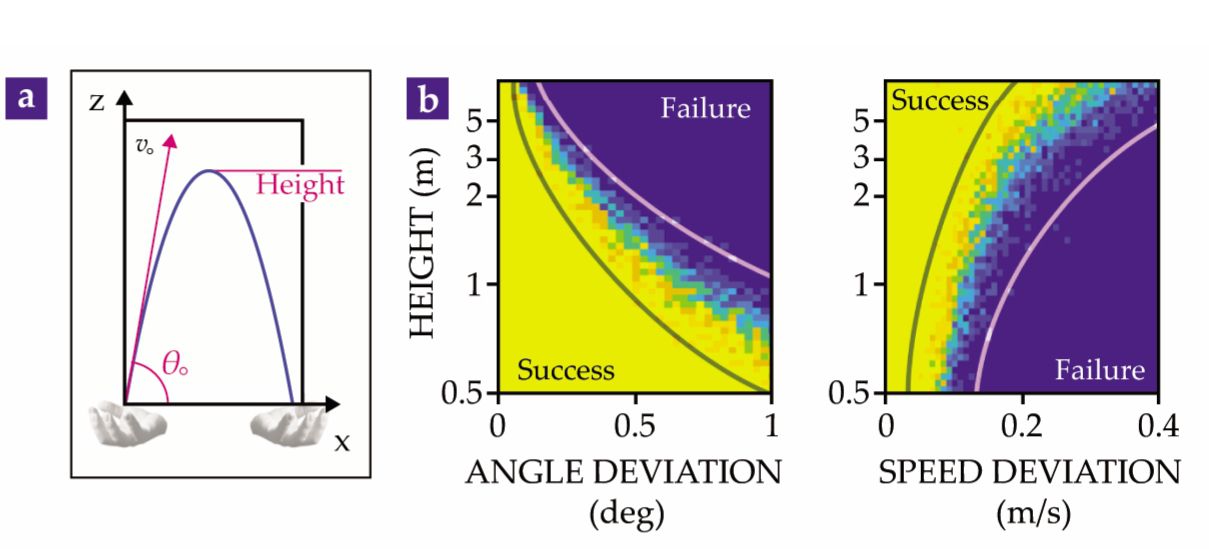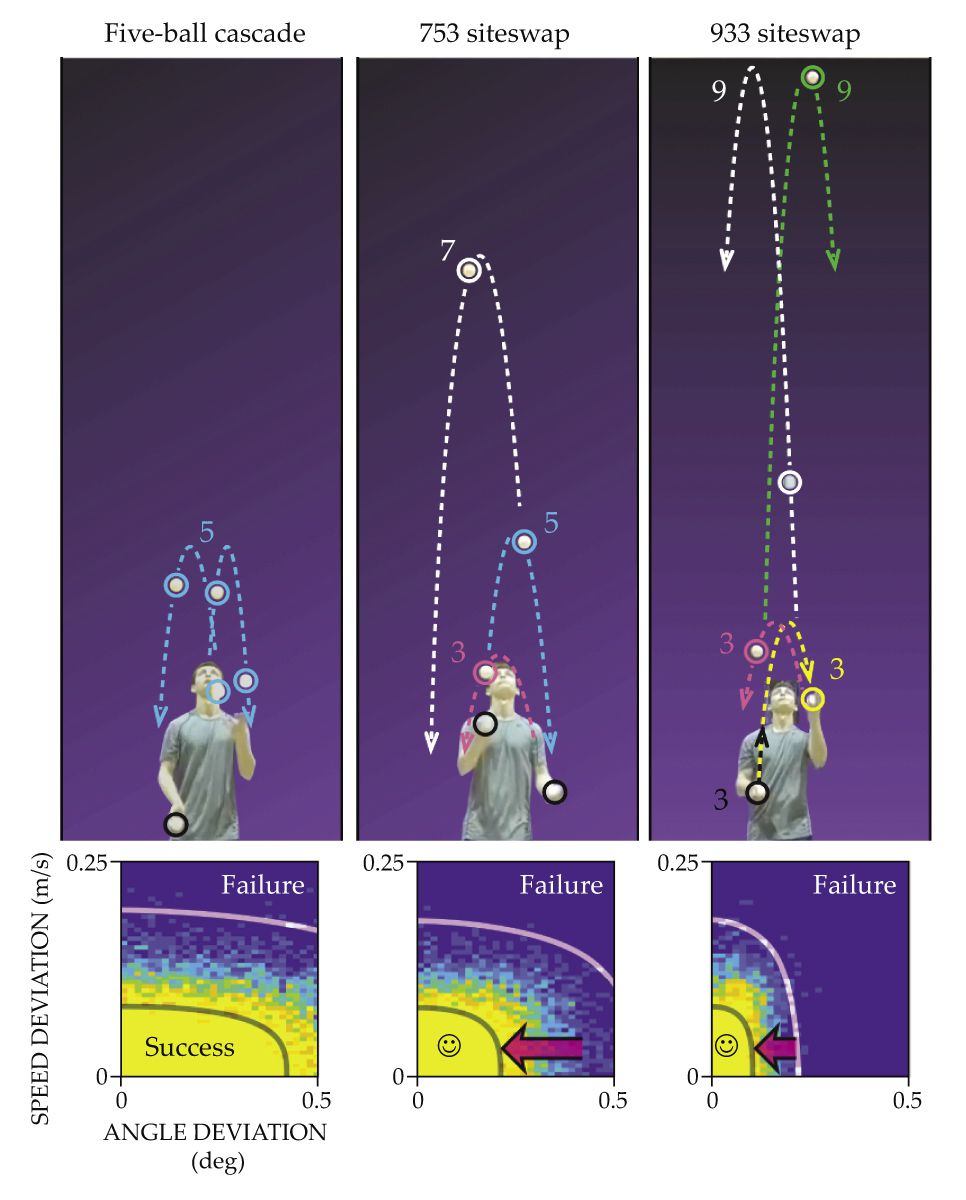Juggling dynamics
DOI: 10.1063/PT.3.4417
In 1993 Claude Shannon, founder of information theory, wrote a popular analysis of juggling, and he even accompanied the article with a working model of a juggling robot. Building such a robot—in fact, juggling at all—is remarkable, because it seems to require faster reaction times than most of us can muster. Speed jugglers can achieve nearly 500 catches in a minute, a rate that allows just 120 ms per catch. Yet typical human reaction times are 250 ms, and even experts in high-speed sports such as tennis take 200 ms to adjust their responses.
So how do jugglers with reaction times no better than 200 ms catch balls every 120 ms? In part, multitasking may allow multiple balls to be processed simultaneously, though how that is done with 11 balls—the Guinness world record—is far from clear. And in part, balls are not thrown to random locations, so each ball need not be tracked and caught independently. Indeed, up to five balls can be juggled while the juggler is blindfolded. Jugglers rely on making accurate throws and predictions of where the balls will travel. The accuracy required is a measure of how unstable—and thus how difficult—a particular juggling pattern is.
Showers and cascades
Figure
Figure 1.

Trajectories and sensitivities. (a) Two common juggling patterns are shown, each with five balls thrown to nearly identical heights. In the cascade (left), the five balls follow two parabolic trajectories, whereas in the shower (right), they follow one. (b) The seemingly more complicated cascade pattern is significantly less sensitive to deviations in speed than the shower, as indicated by the red arrow. Grey and red lines delimit the bounds within which juggling will always be a success and beyond which it will always be a failure.

The shower pattern (shown on the right), by contrast, lacks symmetry and can be performed with either even or odd numbers of balls. Although the pattern is dynamically simpler, it’s also less stable—and thus more difficult—than the cascade. To appreciate why, consider the sensitivity plots (figure
Both panels show the results of simulated parabolic trajectories under gravity. Figure
Figure 2.

An ideal throw and catch (a) with initial speed v0 and angle θ0. (b) Successful and failed catches occur in yellow and dark blue regions, respectively, for five-ball cascade patterns that include deviations in throw angle (left) and throw speed (right). At large heights, a juggler can tolerate large deviations in speed but little deviation in angle, whereas at low heights, the opposite is true.

The take-home message of figure
For throws to the same height, the two patterns are indistinguishable in sensitivity to throw angle. That feature makes sense in terms of the dynamics of the problem. The trajectories of both patterns are parabolic and nearly identical, so changing the throw angle produces the same displacement of a catch from its expected location in both.
In the shower pattern, each ball travels first through a parabola and then through a quick shuffle, whereas in the cascade, each ball must travel through two parabolas to return to its starting point. So hands must move nearly twice as rapidly in the shower as in the cascade, which makes catches in the shower much more sensitive to timing.
The different effects of throw angle and speed can be quantified by plotting sensitivities of throws to independent deviations in the two parameters, shown in figure
Initial speed, on the other hand, chiefly affects the timing of the catch. And because greater heights are produced at lower hand frequencies, higher throws provide more tolerance to time variation. So for high, nearly vertical throws, it’s speed, not angle, that largely determines the time between throw and catch. The effects—particularly for higher throws—are that throw angle determines the location of a catch, whereas throw speed determines its timing. This distinguishes juggling from darts and other throwing games in which targeting accuracy does not depend on the relative timing between two hands.
The distinction between angle and speed is complicated by so-called siteswaps, juggling patterns defined by the order in which successive balls are manipulated, often resulting in throws to varying heights. When balls are thrown many meters high, throw angles must be accurate to within 0.1 degree. That’s more than an order of magnitude tighter than is achievable by world-class athletes, and the time between successive catches is shorter than human reaction times. For an analysis of sensitivity plots for several siteswaps, see the online supplement.
Keep your eyes on the flies
It’s unclear how jugglers achieve accuracy and response times beyond apparent physiological limits. But two experiments offer clues to how people can successfully juggle despite these limitations. In 2004 researchers presented evidence that both human and monkey brains can compute trajectories using an internal representation of equations of motion. According to that picture, jugglers keep track of the locations of their balls—and so effectively extend their reaction times—using dynamical prediction. Just as an outfielder predicts where a fly ball will land, a juggler predicts trajectories from how balls are thrown.
A second clue lies in the well-known but poorly understood phenomenon of muscle memory: A practiced sequence of movements can be recalled and repeated (see Physics Today, November 2018, page 16
Complex tasks like juggling can be successfully performed without understanding the physiology behind motor control, although a deeper understanding is both intriguing and useful. Feedback-controlled robots can juggle a small number of balls by tracking them at 60 Hz. Physiology has apparently found ways to do the same, but with many more balls tracked at the slower rate of just 5 Hz. Unraveling the secrets behind how our nervous systems pull that off may pave the way for more dexterous robots.
Supplemental Material
Juggling dynamics supplement
By: Jonah Botvinick-Greenhouse and Troy Shinbrot
Figure S1.

Several five-ball siteswaps—juggling patterns in which each ball is thrown to heights shown in the panels. Plotted beneath each pattern is the sensitivity of the simulation’s success rate to deviations in speed and angle. As indicated by the red arrows, the cascade (left) has about half the sensitivity to angle deviation as the 753 siteswap, which in turn has about half the sensitivity of the 933 siteswap. Thus the cascade is the easiest to perform and the 933 siteswap is the most difficult. Note that the cascade in the main text was simulated at a greater height than the cascade shown here. Consequently, the sensitivity plot of the five-ball cascade in the main text can tolerate more speed deviation and less angle deviation than this cascade. Videos of the three patterns are available at YouTube5

In a five-ball siteswap, the order in which the throws are made is swapped at constant hand frequency. That is, the sequence 555555. . . , in which each height and period is identical, can be changed to 753753. . . by throwing one ball higher (7), so that it arrives at the catch location two catches later than a standard throw (5) would have. The timing change frees the hand that would have caught that ball, so it can now catch a lower throw (3) two catches earlier than a standard (5). Thus two throws of a height corresponding to a five-ball cascade are swapped for heights of a seven- and a three-ball cascade at a five-ball hand frequency, as shown in the center panel of figure S1.
Similarly, if a ball is thrown higher still (9), even more throws can be made before it lands and is thrown again. The result, shown in the right panel of figure S1, is a 933933. . . siteswap. But that is only one of numerous options; the siteswaps 97531, 94444, and 942 are some alternatives. Readers interested in the mathematics of siteswaps can find a comprehensive overview and demonstrations at Allen Knutson’s YouTube channel, Mathematics of Juggling.
As shown beneath each panel of figure S1, the siteswaps with progressively higher throws reduce the tolerance of successful catches to angle deviation, while leaving their dependence on throw speed unchanged. All siteswaps are simulated at the same frequency, so unlike figure 2 in the main text, the timing of throws and catches is identical. A small throw-angle variation in a high throw will, however, cause the ball to land far from its intended target. Consequently, the higher the throw, the more sensitive the juggling routine is to angle variations.
Figure S1 shows the intrinsic sensitivity of three juggling patterns. From left to right, directing the dynamics toward the most stable regime of motion becomes increasingly difficult (see Physics Today, November 2018, page 16). People can juggle up to five balls blindfolded, as mentioned in the main text, so steering toward stable dynamics seems to be at work.
The stable regions (yellow) in figure S1 are nevertheless smaller than can be practically achieved without additional control: The 933 pattern, for example, would require throw angles to vary by less than 0.1°, more than an order of magnitude tighter than is achievable by world-class jugglers. And yet juggling of even more complex patterns can be achieved with eyes open. But because the available response times are so short, it is unclear what control schemes are actually used.
References
► C. E. Shannon, Claude Elwood Shannon: Collected Papers, Wiley (1993).
► M. Venkadesan, L. Mahadevan, “Optimal strategies for throwing accurately,” R. Soc. Open Sci. 4, 170136 (2017). https://doi.org/10.1098/rsos.170136
► D. E. Angelaki et al., “Neurons compute internal models of the physical laws of motion,” Nature 430, 560 (2004). https://doi.org/10.1038/nature02754
► D. M. Wolpert et al., “An internal model for sensorimotor integration,” Science 269, 1880 (1995). https://doi.org/10.1126/science.7569931
► M. S. Graziano, C. S. Taylor, T. Moore, “Complex movements evoked by microstimulation of precentral cortex,” Neuron 34, 841 (2002). https://doi.org/10.1016/S0896-6273(02)00698-0
► C. G. Fábrica, M. Gómez, A. R. Fariña, “Angle and speed in female handball penalty throwing: Effects of fatigue and player position,” Int. J. Perform. Anal. Sport 8, 56 (2008).
► J. Kalvan, A. Lewbel, When Balls Collide: Understanding the Skill of Juggling, Lulu.com (2018).
More about the Authors
Jonah Botvinick-Greenhouse is a junior mathematics major at Amherst College in Massachusetts, and Troy Shinbrot is a professor in the department of biomedical engineering at Rutgers University in New Jersey.


